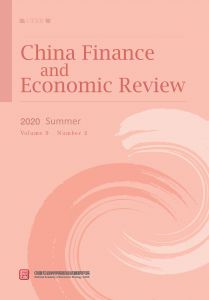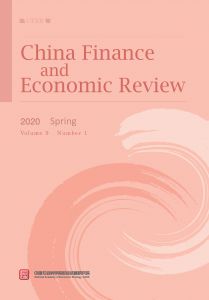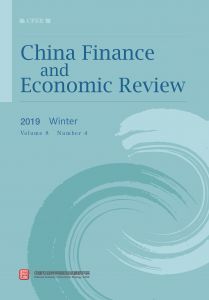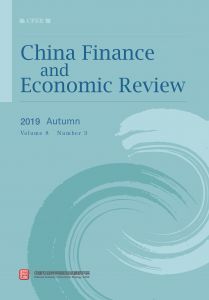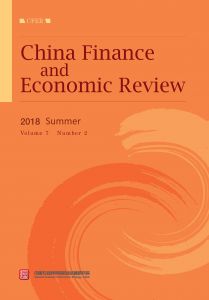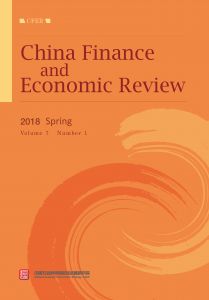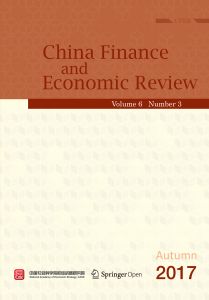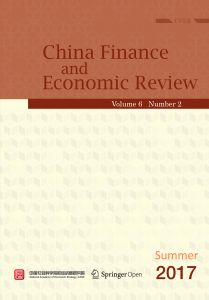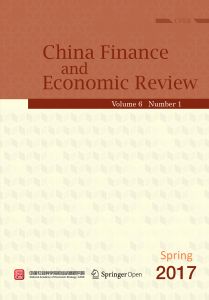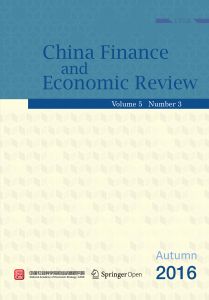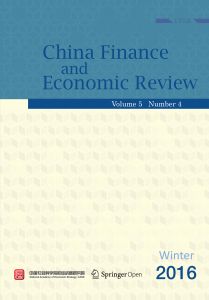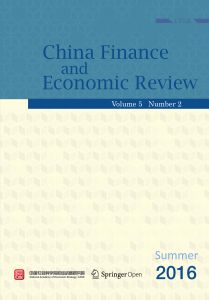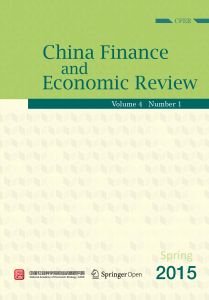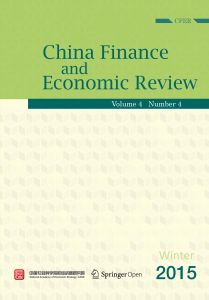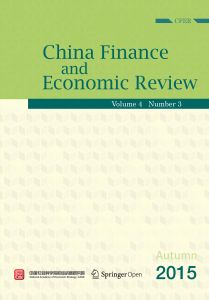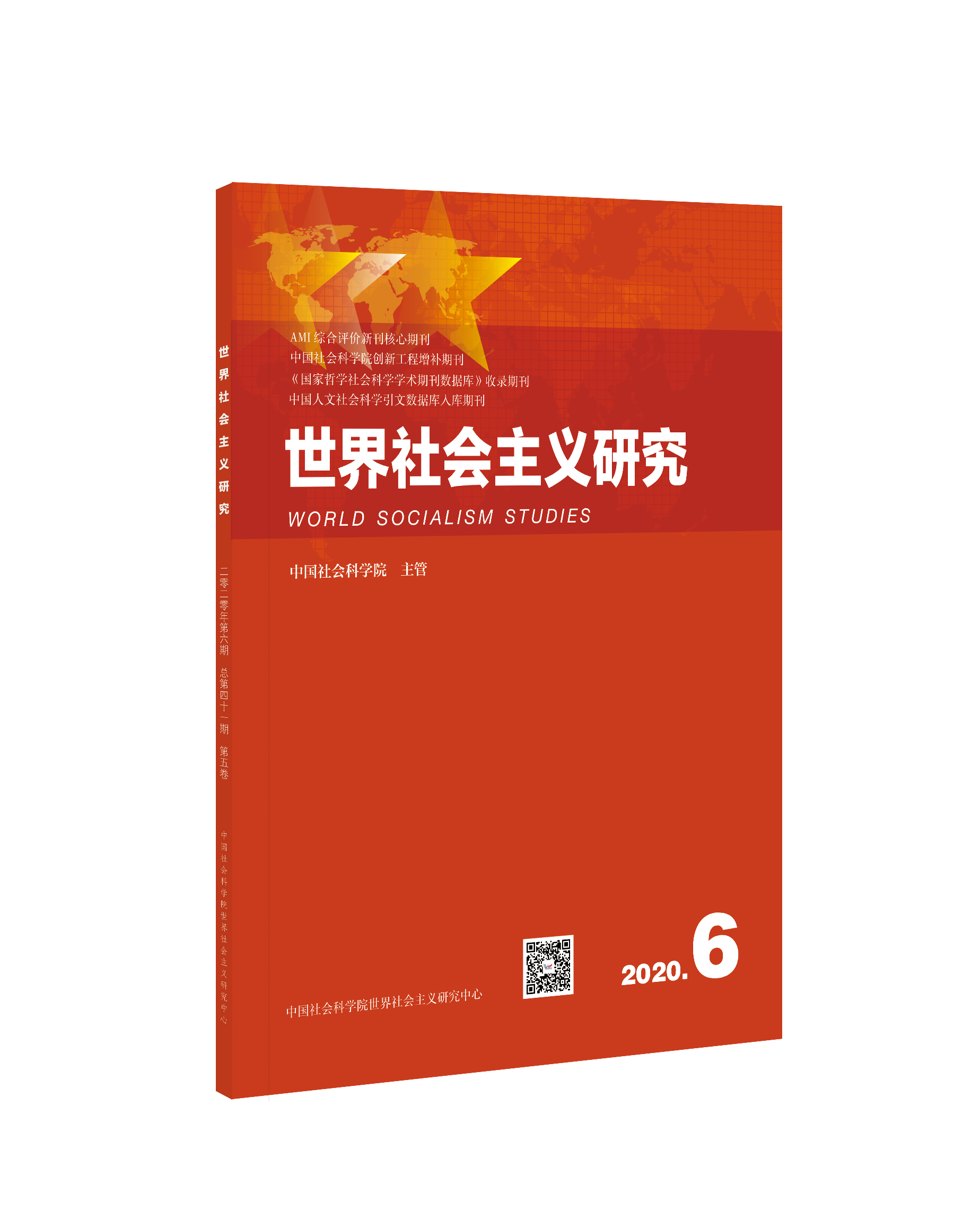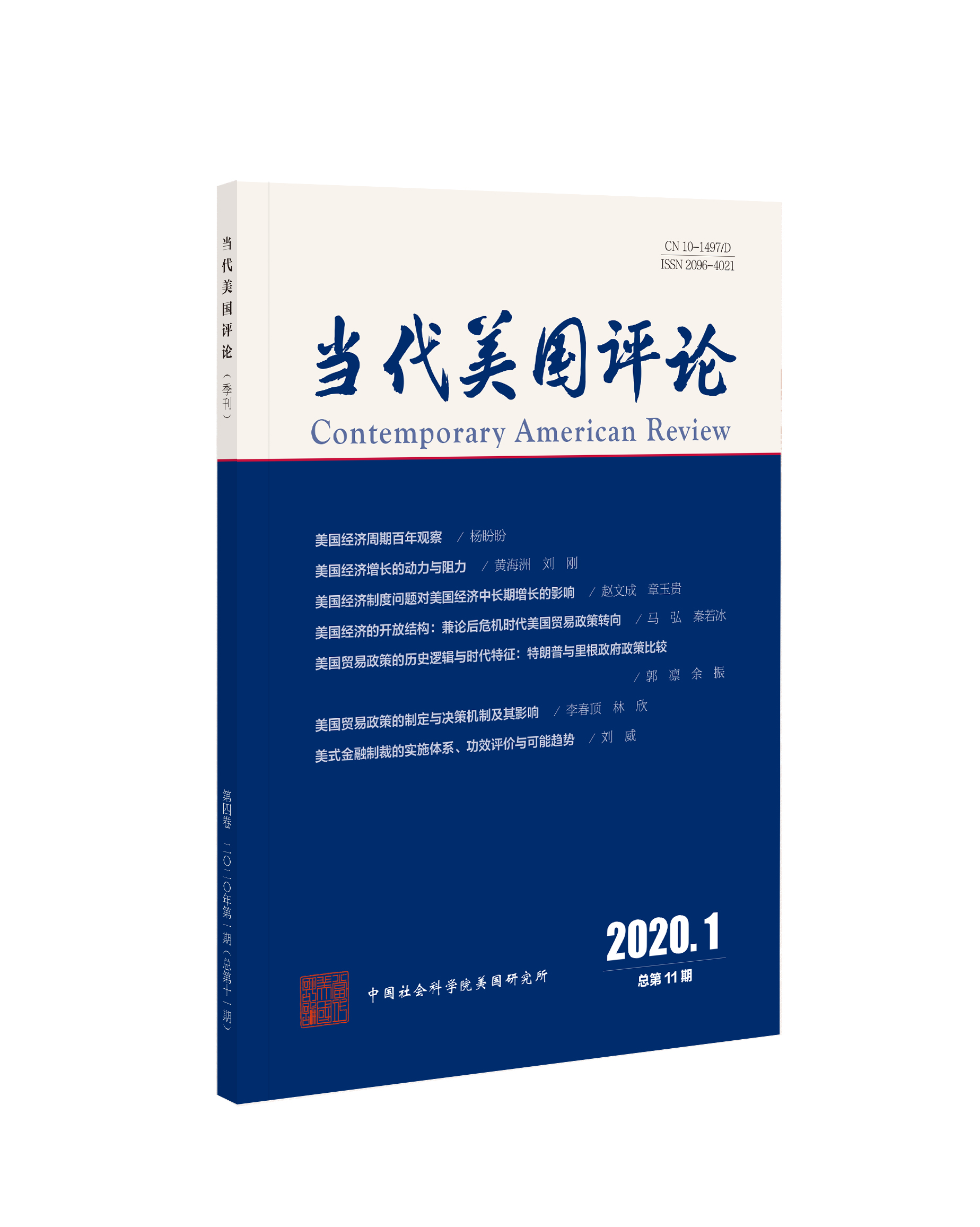最新期刊
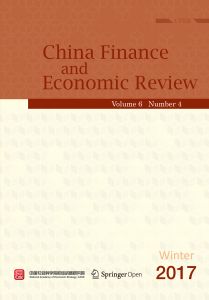
目录
过往期刊
参考文献
-
Instructions for Authors
-
编委会
-
Leisure participation patterns and gender wage gap: Evidence from Chinese manufacturing industry
-
1. Introduction
-
2. Literature review
-
3. Research method
-
4. Results
-
5. Discussion and conclusions
-
-
How do Chinese firms adjust their financial leverage? An empirical investigation using multiple GMM models
-
1. Introduction
-
2. Literature review
-
3. Data and methodology
-
4. Discussion of results
-
5. Conclusions
-
-
Is economic policy uncertainty a major fluctuation factor? Based on a new mixed identification method
-
1. Introduction
-
2. Literature review
-
3. Constructing SVAR model and mixed identification method
-
4. Analysis of empirical results
-
5. Conclusions
-
-
Do exports firms outperform non-export ones? An empirical study on different classification of manufacturing industries in China
-
1. Introduction
-
2. Research framework
-
3. Data and matching
-
4. Performance analysis
-
5. Conclusion and policy implications
-
-
Study on the taxation problems and strategies of digital commodities in e-commerce
-
1. The dispute and advice of the digital commodities’ attribute
-
2. Disputes and countermeasures on the tax payment place of digital commodities’ turnover tax
-
3. Problems and Countermeasures of the tax jurisdiction of the digital commodity income tax
-
4. Discussions and suggestions on the mechanism of tax collection and management of digital commodities
-
5. Conclusions
-
-
The analysis of difficulties in the taxation reform and its solutions in China
-
1. The analysis of the difficulties of tax reform
-
2. The potential solutions to the future tax reform
-
-
China Finance and Economic Review被ESCI数据库正式收录
按年份浏览:
- 全部
- 2020
- 2019
- 2018
- 2017
- 2016
- 2015
- 2014
- 2013
[1][1]Acemoglu, D., & David, A. (2012). What does human capital do? A review of Goldin and Katz’s the race between education and technology. Journal of Economic Literature , 50 (2), 4264-63.
[2][2]Alison, M. J. (2013). We fight for roses too: Time-use and global gender justice. Journal of Global Ethics , 9 (2), 115-129.
[3][3]Baxter, D. (1992). Domestic labour and income inequality. Work , Employment, and Society , 6 (2), 229-49.
[4][4]Becker, G. S. (1964). Human capital . Chicago: University of Chicago Press, 96-113.
[5][5]Becker, G. S. (1965). A theory of the allocation of time. Economic Journal , 75 (299), 493-517.
[6][6]Becker, G. S. (1985). Human capital, effort, and the sexual division of labor. Journal of Labor Economics , 3 (1), S53-S58.
[7][7]Bellas, M. L., Ritchey, P. N., & Parmer, P. (2001). Gender differences in the salaries and salary growth rates of university faculty: An exploratory study. Sociological Perspectives , 44 (2), 163-187.
[8][8]Björn, G., & Li, S. (2000). Economic transformation and the gender earnings gap in urban China. Journal of Population Economics , 13 (2), 305-329.
[9][9]Blau, F., & Lawrence, K. (1994). Rising wage inequality and the U.S. gender gap. American Economic Review Papers and Proceedings , 84 (2), 23-28.
[10][10]Blau, F. D., & Kahn, L. M. (1992). The gender earnings gap: Learning from international comparisons. The American Economic Review , Papers and Proceedings , 82 (2), 533-538.
[11][11]Bian, Y., & Zhang, L. (2013). The relationship between Guanxi culture and Guanxi social capital. The Journal of Humanities , 16 (1), 107-113.
[12][12]Bishop, J., Luo, F., & Wang, F. (2005). Economic transition, gender bias, and the distribution of earnings in China. Journal of Economic Transition , 13 (2), 239-259.
[13][13]Bruhn, M., Karlan, D., & Schoar, A. (2010). What capital is missing in developing countries? American Economic Review , 100 (2), 629-633.
[14][14]Chi, W., & Li, B. (2014). Trends in China’s gender employment and pay gap: Estimating gender pay gaps with employment selection. Journal of Comparative Economics , 42 (3), 708-725.
[15][15]Christina, G., & Uta, S. (2010). How general is human capital? A task-based approach. Journal of Labor Economics , 28 (1), 1-49.
[16][16]Christer, T. (2000). Men, women, and leisure time: Scandinavian evidence of gender inequality. Leisure Sciences , 22 (2), 109-122.
[17][17]Duin, D. K., Golbeck, A. L., & Keippel, A. E. (2015). Using gender-based analyses to understand physical inactivity among women in Yellowstone County, Montana. Evaluation & Program Planning , 51, 45-52.
[18][18]Dong, X., & Zhang, L. (2009). Economic transition and gender differentials in wages and productivity: Evidence from Chinese manufacturing enterprises. Journal of Development Economics , 88 (1), 144-156.
[19][19]Ester, V. O., & Ichiro, K. (2015). The measurement of social capital. Gaceta Sanitaria , 29 (1), 62-64.
[20][20]Gareth, D. L., & Ric, H. (2014). Gender differences in social capital investment: Theory and evidence. Economic Modelling , 37 (37), 377-385.
[21][21]Glinskaya, E., & Mroz, T. A. (2000). The gender gap in wages in Russian from 1992 to 1995. Journal of Population Economics . 13 (2), 353-386.
[22][22]Gimeneznadal, J. I., & Sevilla, A. (2012). Trends in time allocation: A cross-country analysis. European Economic Review , 56 (6), 1338-1359.
[23][23]Goldin, C. D., & Lawrence, F. K. (2007). Long-run changes in the wage structure: Narrowing, widening, polarizing. Brookings Papers on Economic Activity , 2007 (2), 135-165.
[24][24]Gustafsson, B., & Li, S. (2000). Economic transformation and the gender earnings gap in urban China. Journal of Population Economics , 13 (2), 305-329.
[25][25]Jacobsen, J., & Laurence, L. (1995). The Effects of intermittent labor force attachment on female earnings. Monthly Labor Review , 118 (9), 14-19.
[26][26]Jacob, M. (1958). Investment in human capital and personal income distribution. Journal of Political Economy , 66 (4), 281-302.
[27][27]Joseph, G. A., & Rebecca, M. B. (1999). Race and gender in the labor market. Handbook of labor economics , 3, part c (3), 3144-3213.
[28][28]Kim, S. M. (2014). The impacts of gender differences in social capital on microenterprise business start-up. Journal of Women and Social Work , 29 (4), 404-417.
[29][29]Liu, P., Meng, X., & Zhang, J. (2000). Sectoral gender wage differentials and discrimination in the transitional Chinese economy. Journal of Population Economics 13, 331-352.
[30][30]Loureiro, P., Carneiro, F. G., & Sachsida, A. (2004). Race and gender discrimination in the labor market: An urban and rural sector analysis for Brazil. Journal of Economic Studies , 31 (5), 129-143.
[31][31]Margaret, E. B., & Jeanne, E. A. (2009). Gendered time use at home: An ethnographic examination of leisure time in middle class families. Leisure Studies , 28 (2), 121-142.
[32][32]Mattingly, M. J., & Blanchi, S. M. (2003). Gender differences in the quantity and quality of free time: The U.S. experience. Social Forces , 81 (3), 999-1030.
[33][33]Maurer, F. M., Rawski, T. G., & Zhang, W. (1999). Inequality in the rewards for holding up half the sky: Gender wage gaps in China’s urban labor market, 1998-1994. China Journal , 41 (41) 55-88.
[34][34]Michael, B., & Oksana, L. (2011). On the time allocation of married couples since 1960. Journal of Macroeconomics , 33 (4), 491-510.
[35][35]Mincer, J. (1974). Schooling, experience, and earnings . New York: Columbia University Press, 218-223.
[36][36]Miriam, B., & Julio, R. R. (2008). The wage gap and the leisure gap for double-earner couples. Journal of Population Economics , 21 (2), 281-304.
[37][37]Orhan, K. (2006). Occupational gender wage discrimination in Turkey. Journal of Economic Studies , 33 (2), 130-143.
[38][38]Parsons, T., & Bales, R. (1956). Family, socialization and interaction process . Abingdon: Routledge & Kegan Paul, 133-186.
[39][39]Phelps, E. S. (1972). The statistical theory of racism and sexism. American Economic Review , 62 (4), 659-661.
[40][40]Richard, S., & Shelly, J. L. (1981). Private discrimination and social intervention in competitive labor markets. Working paper, No.19-81.
[41][41]Sayer, L. C. (2005). Gender, time, and inequality: Trends in women’s and men’s paid work, unpaid work, and free time. Social Forces , 84 (1), 285-303.
[42][42]Spence, A. M. (1973). Job market signaling. Quarterly Journal of Economics , 87 (3), 355-74.
[43][43]Tan, L., & Li, J. (2002). What marriage and employment mean to women? -An analysis based on gender and social capital. Collection and Women’s Studies (Funv Yanjiu Luncong) , 47 (4), 5-11.
[44][44]Tanja, V. L. (2015). International encyclopedia of the social & behavioral sciences (Second Edition) . Amsterdam: Elsevier Ltd, 369-372.
[45][45]Weiss, A. (1995). Human capital vs. signaling explanations of wages. Journal of Economic Perspectives , 9 (4), 133-154.
[46][46]Yuan, K., Niu, G., & Fan, C. (2013). The effect of skip-generation raising on personal development. Journal of Science of Social Psychology , 148 (7), 3-6.
[47][47]Zhang, M. (2008). Gender difference and social capital inequality. Forward Position (Qianyan) , 9, 139-142.
[48][48]Zhao, X. (2012). Review of social capital measurement. China Population, Resources and Environment (Zhongguo Renkou Ziyuan Yu Huanjing) , 22 (7), 127-133.
[49][49]Adrian, T., & Boyarchenko, N. (2015). Intermediary leverage cycles and financial stability. Federal Reserve Bank of New York Staff Reports , No. 567.
[50][50]Alves, P. F. P., & Ferreira, M. A. (2011). Capital structure and law around the world. Journal of Multinational Financial Management , 21 (3), 119-150.
[51][51]Andrade, G., & Kaplan, S. N. (1998). How costly is financial (not economic) distress? Evidence from highly levered transactions that became distressed. The Journal of Finance , 53 (5), 1443-1493.
[52][52]Ang, J. S., Fatemi, A., & Tourani-Rad, A. (1997). Capital structure and dividend policies of Indonesian firms. Pacific-Basin Finance Journal , 5 (1), 87-103.
[53][53]Arellano, M., & Bover, O. (1995). Another look at the instrumental variable estimation of error-components models. Journal of Econometrics , 68 (1), 29-51.
[54][54]Berger, P. G., Ofek, E., & Yermack, D. L. (1997). Managerial entrenchment and capital structure decisions. Journal of Finance , 52 (4), 1411-1438.
[55][55]Bessler, W., Drobetz, W., & Pensa, P. (2008). Do managers adjust the capital structure to market value changes? Evidence from Europe. Zeitschrift für Betriebswirtschaft , 78 (6), 113-145.
[56][56]Bevan, A., & Danbolt, J. (2002). Capital structure and its determinants in the UK: A decompositional analysis. Applied Financial Economics , 12 (3), 159-170.
[57][57]Blundell, R., & Bond, S. (2000). GMM estimation with persistent panel data: An application to production functions. Econometric Reviews , 19 (3), 321-340.
[58][58]Bradley, M., Jarrell, G. A., & Kim, H. E. (1984). On the existence of an optimal capital structure: Theory and evidence. The Journal of Finance , 39 (3), 857-878.
[59][59]Brandt, L., & Li, H. (2003). Bank discrimination in transition economies: Ideology, information, or incentives? Journal of Comparative Economics , 31 (3), 387-413.
[60][60]Bris, A., Welch, I., & Zhu, N. (2006). The cost of bankruptcy: Chapter 11 liquidation versus Chapter 7 reorganization. The Journal of Finance , 61 (3), 1253-1303.
[61][61]Byoun, S. (2008). How and when do firms adjust their capital structures towards targets? The Journal of Finance , 63 (3), 3069-3095.
[62][62]Byoun, S., & Xu, Z. (2013). Why do some firms go debt free? Asia-Pacific Journal of Financial-Studies , 42 (1), 1-38.
[63][63]Chakraborty, I. (2010). Capital structure in an emerging stock market: The case of India. Research in International Business and Finance , 24 (3), 295-314.
[64][64]Chang, R. P., & Rhee, S. G. (1990). The impact of personal taxes on corporate dividend policy and capital structure decisions. Financial Management , 19 (2), 21-31.
[65][65]Chen, J. J. (2004). Determinants of capital structure of Chinese-listed companies. Journal of Business Research , 57 (12), 1341-1351.
[66][66]Cheng, S. R., & Shiu, C. Y. (2007). Investor protection and capital structure: International evidence. Journal of Multinational Financial Management , 17 (1), 30-44.
[67][67]Colombage, S. R. (2005). Sectoral analysis of corporate capital structure choice-Emerging market evidence from Sri Lanka. Journal of Asia-Pacific Business , 6 (3), 5-35.
[68][68]Cook, D. O., & Tang, T. (2010). Macroeconomic conditions and capital structure adjustment speed. Journal of Corporate Finance , 16 (1), 73-87.
[69][69]De Jong, A., Kabir, R., & Nguyen, T. T. (2008). Capital structure around the world: The roles of firm-and country specific determinants. Journal of Banking & Finance , 32 (9), 1954-1969.
[70][70]Deesomsak, R., Paudyal, K., & Pescetto, G. (2004). The determinants of capital structure: Evidence from the Asia Pacific region. Journal of Multinational Financial Management , 14 (4), 387-405.
[71][71]Donaldson, G. (1962). Corporate debt capacity: A study of corporate debt policy and the determination of corporate debt capacity. Journal of Finance , 17 (3), 81-93.
[72][72]Elsas, R., & Florysiak, D. (2015). Dynamic capital structure adjustment and the impact of fractional dependent variables. Journal of Financial and Quantitative Analysis , 50 (5), 1105-1133.
[73][73]Faccio, M., Masulis, R. W., & McConnell, J. J. (2006). Political connections and corporate bailouts. The Journal of Finance , 61 (6), 2597-2635.
[74][74]Fan, J. P. H., Titman, S., & Twite, G. J. (2008). An international comparison of capital structure and debt maturity choices. AFA 2005, Philadelphia Meetings Paper.
[75][75]Fattouh, B., Scaramozzino, P., & Harris, L. (2005). Capital structure in South Korea: A quantile regression approach. Journal of Development Economics , 76 (1), 231-250.
[76][76]Faulkender, M., & Wang, R. (2006). Corporate financial policy and the value of cash. Journal of Finance , 61 (4), 1957-1990.
[77][77]Fischer, E. O., Heinkel, R., & Zechner, J. (1989), Dynamic capital structure choice: Theory and tests. The Journal of Finance , 44 (1), 19-40.
[78][78]Flannery, M. J., & Hankins, K. W. (2007). A theory of capital structure adjustment speed. Working Paper, University of Florida.
[79][79]Flannery, M. J., and Rangan, K. P. (2006). Partial adjustment toward target capital structures. Journal of Financial Economics , 79 (3), 469-506.
[80][80]Frank, M. Z., & Goyal, V. K. (2003). Testing the pecking order theory of capital structure. Journal of Financial Economics , 67 (2), 217-248.
[81][81]Getzmann, A., Lang, S., & Spremann, K. (2014). Target capital structure and adjustment speed in Asia. Asia-Pacific Journal of Financial Studies , 43 (1), 1-30.
[82][82]Guo, L., Smallman, C., & Radford, J. (2013). A critique of corporate governance in China. International Journal of Law and Management , 55 (4), 257-272.
[83][83]Halov, N., & Heider, F. (2006). Capital structure, risk and asymmetric information. SSRN Working Paper, EFA 2004, Maastricht.
[84][84]Hennessy, C. A., & Whited, T. M. (2007). How costly is external financing? Evidence from a structural estimation. The Journal of Finance , 62 (4), 1705-1745.
[85][85]Hovakimian, A., & Li, G. (2009). Do firms have unique target debt ratios to which they adjust? Working Paper, http://papers.ssrn.com/sol3/papers.cfm?abstract_id=1138316.
[86][86]Hovakimian, A., Opler, T., & Titman, S. (2001). The debt-equity choice. The Journal of Financial and Quantitative Analysis , 36 (1), 1-24.
[87][87]Huang, M. (2003). Liquidity shocks and equilibrium liquidity premia. Journal of Economic Theory , 109 (1), 104-129.
[88][88]Jalilvand, A., & Harris, R. S. (1984). Corporate behaviour in adjusting to capital structure and dividend targets: An econometric study. The Journal of Finance , 39 (1), 127-145.
[89][89]Jensen, M. C. (1999). Agency cost of free cash flow, corporate finance, and takeovers. American Economic Review , 76 (2), 323-329.
[90][90]Jung, K., & Kim, B. (2008). Corporate cash holdings and tax-induced debt financing. Asia-Pacific Journal of Financial Studies , 37 (6), 983-1023.
[91][91]Juselius, M., & Drehmann, M. (2015). Leverage dynamics and the real burden of debt. BIS Working Papers, No. 501.
[92][92]Kayo, E. K., & Kimura, H. (2011). Hierarchical determinants of capital structure. Journal of Banking & Finance , 35 (2), 358-371.
[93][93]King, M. R., & Santor, E. (2008). Family values: Ownership structure, performance and capital structure of Canadian firms. Journal of Banking & Finance , 32 (11), 2423-2432.
[94][94]Korajczyk, R., & Levy, A. (2003). Capital structure choice: Macroeconomic conditions and financial constraints. Journal of Financial Economics , 68 (1), 75-109.
[95][95]Leary, M. T., & Roberts, M. R. (2005). Do firms rebalance their capital structures? The Journal of Finance , 60 (6), 2575-2619.
[96][96]Leland, H. E., & Toft, K. B. (1996). Optimal capital structure, endogenous bankruptcy, and the term structure of credit spreads. The Journal of Finance , 51 (3), 987-1019.
[97][97]MacKay, P., & Phillips, G. M. (2005). How does industry affect firm financial structure? The Review of Financial Studies , 18 (4), 1433-1466.
[98][98]Miguel, A., & Pindado, J. (2001). Determinants of capital structure: New evidence from Spanish panel data. Journal of Corporate Finance , 7 (1), 77-99.
[99][99]Modigliani, F., & Miller, M. H. (1958). The cost of capital, corporation finance and the theory of investment. The American Economic Review , 48 (3), 261-297.
[100][100]Modigliani, F., & Miller, M. H. (1963). Corporate income taxes and the cost of capital: A correction, The American Economic Review , 53 (3), 433-443.
[101][101]Muradoglu, Y. G., & Sivaprasad, S. (2011). Capital structure and abnormal returns. International Business Review , 21 (3), 328-341.
[102][102]Myers, S. C. (1984). The capital structure puzzle. The Journal of Finance , 39 (3), 575-592.
[103][103]Myers, S. C., & Majluf, N. S. (1984). Corporate financing and investment decisions when firms have information the investors do not have. Journal of Financial Economics , 13 (2), 187-221.
[104][104]Pandey, I. M. (2001). Capital structure and the firm characteristics: Evidence from an emerging market. Working paper, Indian Institute of Management, Ahmedabad.
[105][105]Poncet, S., Steingress, W., & Vandenbussche, H. (2010). Financial constraints in China: Firm-level evidence. China Economic Review , 21 (3), 411-422.
[106][106]Pound, J., & Zeckhauser, R. (1990). Clearly heard on the street: The effect of takeover rumors on stock prices. Journal of Business , 63 (3), 291-318.
[107][107]Qian, Y. (1995). Reforming corporate governance and finance in China. In: Aoki, M., & Kim, H. K. (Eds.), Corporate governance in transitional economies: Insider control and the role of banks (215-252), Washington, DC: The International Bank for Reconstruction and Development.
[108][108]Rajan, R. G., & Zingales, L. (1995). What do we know about capital structure? Some evidence from international data. The Journal of Finance , 50 (5), 1421-1460.
[109][109]Rehman, A., & Wang, M. (2015). Corporate cash holdings and adjustment behaviour in Chinese firms: An empirical analysis using generalized method of moments. Australasian Accounting Business & Finance Journal , 9 (4), 20-37.
[110][110]Rehman, A. U., Wang, M., & Kabiraj, S. (2017). Mean reverting leverage policy in China: Theory and evidence from industrial and sectorial level unit root analysis. Journal of Asia Business Studies (forthcoming) .
[111][111]Rehman, A. U., Wang, M., & Yu, H. (2016). Dynamics of financial leverage across firm life cycle in Chinese firms: An empirical investigation using dynamic panel data model. China Finance and Economic Review , 4 (1), 19.
[112][112]Scott, J. H. (1976). A theory of optimal capital structure. The Bell Journal of Economics , 7 (1), 33-54.
[113][113]Taggart, R. A. Jr. (1985). Secular patterns in the financing of U.S. corporations. In: Friedman, B. M. (Ed.), Corporate capital structures in the United States (13-80). New York: University of Chicago Press.
[114][114]Titman, S., & Wessels, R. (1988). The determinants of capital structure choice. The Journal of Finance , 43 (1), 1-19.
[115][115]Uysal, V. B. (2011). Deviation from the target capital structure and acquisition choices. Journal of Financial Economics , 102 (3), 602-620.
[116][116]Welch, I. (2004). Capital structure and stock returns. Journal of Political Economy , 112 (1), 106-131.
[117][117]Welch, I. (2007). Common flaws in empirical capital structure research. AFA 2008, New Orleans Meetings Paper.
[118][118]Wiwattanakantang, Y. (1999). An empirical study on the determinants of the capital structure of Thai firms. Pacific-Basin Finance Journal , 7 (3-4), 371-403.
[119][119]Yau, J., Lau, E., & Liwan, A. (2008). Do Malaysian firms practice the pecking order theory in their capital structure? Proceedings of the MFA Conference 2008.
[120][120]Abel, A. B. (1983). Optimal investment under uncertainty. The American Economic Review , 73 (1), 228-233.
[121][121]Bachmann, R., & Bayer, C. (2013). Wait-and-see’business cycles? Journal of Monetary Economics , 60 (6), 704-719.
[122][122]Bachmann, R., Elstner, S., & Sims, E. R. (2013). Uncertainty and economic activity: Evidence from business survey data. American Economic Journal: Macroeconomics , 5 (2), 217-249.
[123][123]Baker, S.R., Bloom, N., & Davis, S. J. (2015). Measuring economic policy uncertainty. National Bureau of Economic Research, Working Paper No. 21633.
[124][124]Basu, S., & Bundick, B. (2012). Uncertainty shocks in a model of effective demand. National Bureau of Economic Research, Working Paper No. 18420.
[125][125]Bernanke, B. S. (1983). Irreversibility, uncertainty, and cyclical investment. The Quarterly Journal of Economics , 98 (1), 85-106.
[126][126]Blanchard, O. J., & Quah, D. (1989). The dynamic effects of aggregate demand and supply disturbances. American Economic Review , 79 (4), 655-673.
[127][127]Bloom, N. (2009). The impact of uncertainty shocks. Econometrica , 77 (3), 623-685.
[128][128]Bloom, N. (2014). Fluctuations in uncertainty. The Journal of Economic Perspectives , 28 (2), 153-175.
[129][129]Born, B., & Pfeifer, J. (2014). Policy risk and the business cycle. Journal of Monetary Economics , 68 (1), 68-85.
[130][130]Brandt, L., Tombe, T., & Zhu, X. (2013). Factor market distortions across time, space and sectors in China. Review of Economic Dynamics , 16 (1), 39-58.
[131][131]Cao, C. (2013). Between the transfer of the political power and the corporate investment: The logic of China. Management World (Guanli Shijie) , 1, 143-156.
[132][132]Carrière-Swallow, Y., & Céspedes, L. F. (2013). The impact of uncertainty shocks in emerging economies. Journal of International Economics , 90 (2), 316-325.
[133][133]Chen, L., & Tian, l., (2014). Effects OF China’s monetary policy shocks: A perspective of instruments. China Economic Quarterly (Jingjixue Jikan) , 14 (1), 285-304.
[134][134]Dornbusch, R., Fischer, S., & Startz, R. (2010). Macroeconomics . Beijing: China Remin University Press. (in Chinese)
[135][135]Fernández-Villaverde, J., Guerrón-Quintana, P., Kuester, K., & Rubio-Ramírez, J. (2015). Fiscal volatility shocks and economic activity. The American Economic Review , 105 (11), 3352-3384.
[136][136]Fry, R., & Pagan, A. (2011). Sign restrictions in structural vector autoregressions: A critical review. Journal of Economic Literature , 49 (4), 938-960.
[137][137]Gali, J. (1992). How well does the IS-LM model fit postwar US data? The Quarterly Journal of Economics , 107 (2), 709-738.
[138][138]Gilchrist, S., Sim, J. W., & Zakrajšek, E. (2014). Uncertainty, financial frictions, and investment dynamics. National Bureau of Economic Research, Working Paper No. 20038.
[139][139]Gong, M., & Li, W. (2007). Analysis of effect of aggregate supply and aggregate demand shocks on economic fluctuations. Economic Research Journal (Jingji Yanjiu) , 11, 32-44.
[140][140]Handley, K., & Limao, N. (2015). Trade and investment under policy uncertainty: Theory and firm evidence. American Economic Journal: Economic Policy , 7 (4), 189-222.
[141][141]Hartman, R. (1972). The effects of price and cost uncertainty on investment. Journal of economic theory , 5 (2), 258-266.
[142][142]Holz, C. A. (2014). Monthly industrial output in China 1980-2012. China Economic Review , 28 (4), 1-16.
[143][143]Hsieh, C. T., & Klenow, P. J. (2009). Misallocation and manufacturing TFP in China and India. Quarterly Journal of Economics , 124 (4), 1403-1448.
[144][144]Huang, G., & Zhao, L. (2010). Supply shocks, demand shocks, and business cycle effect. Journal of Financial Research (Jinrong Yanjiu) , 6, 1-16.
[145][145]Huang, N., & Guo, P. (2015). The Impact of economic policy uncertainty on macroeconomy and its regional difference—Evidence from China with the panel VAR model. Finance & Economics (Caijing Kexue) , 6, 61-70.
[146][146]Huang, Y. (2016). Economic policy uncertainty, property discrimination, and national progress and people retrogress in leverage. Caixin online, July, 22.
[147][147]Julio, B., & Yook, Y. (2012). Political uncertainty and corporate investment cycles. The Journal of Finance , 67 (1), 45-83.
[148][148]Kellogg, R. (2014). The effect of uncertainty on investment: evidence from Texas oil drilling. The American Economic Review , 104 (6), 1698-1734.
[149][149]Kilian, L., & Murphy, D. P. (2012). Why agnostic sign restrictions are not enough: understanding the dynamics of oil market VAR models. Journal of the European Economic Association , 10 (5), 1166-1188.
[150][150]Li, F., & Yang, M. (2015). Can economic policy uncertainty influence corporate investment? Journal of Financial Research (Jinrong Yanjiu) , 4, 115-129.
[151][151]Lindé, J. (2005). Estimating New-Keynesian Phillips curves: A full information maximum likelihood approach. Journal of Monetary Economics , 52 (6), 1135-1149.
[152][152]Liu, S., Zhang, X., & Zhang, P. (2005). Smoothing the business cycles at a moderately high altitude. Economic Research Journal (Jingji Yanjiu) , 11, 4-10.
[153][153]Mumtaz, H., & Surico, P. (2009). The transmission of international shocks: A factor-augmented VAR approach. Journal of Money, Credit and Banking , 41 (1), 71-100.
[154][154]Nie, H., & Jian, R. (2011). Productivity and resource misallocation of China’s manufacturing enterprises. The Journal of World Economy (Shijie Jingji) , 7, 27-42.
[155][155]Ouyang, Z., & Shi, H., (2010). China’s economic growth and random shocks effect of inflation. Economic Research Journal (Jingji Yanjiu) , 7, 68-7.
[156][156]Peersman, G. (2005). What caused the early millennium slowdown? Evidence based on vector autoregressions. Journal of Applied Econometrics , 20 (2), 185-207.
[157][157]Peng, F., Fan, H., Lian, Y., & Zhan, K. (2012). Identification of China’s types of inflation—Firm level evidence from China. Economic Research Journal (Jingji Yanjiu) , 8, 70-80.
[158][158]Rubio-Ramirez, J. F., Waggoner, D. F., & Zha, T. (2010). Structural vector autoregressions: Theory of identification and algorithms for inference. The Review of Economic Studies , 77 (2), 665-696.
[159][159]Scholl, A., & Uhlig, H. (2008). New evidence on the puzzles: Results from agnostic identification on monetary policy and exchange rates. Journal of International Economics , 76 (1), 1-13.
[160][160]Sun, L., Ford, J. L., & Dickinson, D. G. (2010). Bank loans and the effects of monetary policy in China: VAR/VECM approach. China Economic Review , 21 (1), 65-97.
[161][161]Tian, L., & Lin, J. (2016) Does economic policy uncertainty have both output effect and inflation effect? Nankai Economic Studies (Nankai Jingji Yanjiu) , 2, 3-24.
[162][162]Uhlig, H. (1994). What macroeconomists should know about unit roots: A Bayesian perspective. Econometric Theory , 10 (3-4), 645-671.
[163][163]Uhlig, H. (2005). What are the effects of monetary policy on output? Results from an agnostic identification procedure. Journal of Monetary Economics , 52 (2), 381-419.
[164][164]Wang, J., Guo, X., & Cai, J. (2011). Overshooting under expanding monetary policy, consumption control, and inflation inertia. Management World (Guanli Shijie) , 3, 7-21.
[165][165]Wang, S., & Hu, J. (2009). Trend cyclical decomposition of China’s GDP and lasting effect of random shocks. Economic Research Journal (Jingji Yanjiu) , 4, 65-76.
[166][166]Wang, W., Zhang, N., & Yue, C. (2015). The identification and effect of fiscal policy shocks in China: SVAR analysis based on sign restriction. Journal of Finance and Economics (Caijing Yanjiu) , 41 (6), 70-81.
[167][167]Wang, X., Xu, X., & Li, X. (2009). Turnover of local officials and economic growth. China Economic Quarterly (Jingjixue Jikan) , 8 (4), 1301-1328.
[168][168]Xu, Y., Qian, X., & Li, W. (2013). Political uncertainty, political connections and investment by private enterprises. Management World (Guanli Shijie) , 5, 116-130.
[169][169]Zhang, J., & Gao, Y. (2007). Term limits and rotation of Chinese governors: Do they matter to economic growth?. Economic Research Journal (Jingji Yanjiu) , 7, 91-103.
[170][170]Zhang, J., Chen, S., & Jefferson, H. G. (2009). Structural reform and industrial growth in China. Economic Research Journal (Jingji Yanjiu) , 7, 4-20.
[171][171]Zhao, W., & Zhang, Y. (2012). Monetary policy shocks and exchange rate dynamics. Journal of Financial Research (Jinrong Yanjiu) , 8, 1-15.
[172][172]Bao, Q., Ye, N. H., & Shao, M. (2014). On learning-by-exporting effect, heterogeneity matching and enterprise productivity from a dynamic perspective. The Journal of World Economy (Shijie Jingji) , 4, 26-48.
[173][173]Berman, N., Martin, P., & Mayer, T. (2012). How do different exporters react to exchange rate changes? Theory, empirics and aggregate implications. Quarterly Journal of Economics , 127 (1), 437-492.
[174][174]Bernard, A. B., Jensen, J. B., & Lawrence, R. Z. (1995). Exporters, Jobs, and wages in U.S. manufacturing: 1976-1987. Brookings Papers on Economic Activity , 1, 67-119.
[175][175]Blundell, R., & Dias, M. C. (2000). Evaluation methods for non-experimental data. Fiscal Studies , 21 (4), 427-468.
[176][176]Brandt, L., Van Biesebroeck, J., & Zhang, Y. (2012). Creative accounting or creative destruction? Firm-level productivity growth in Chinese manufacturing. Journal of Development Economics , 97 (2), 339-351.
[177][177]Chaney, T. (2016). Liquidity constrained exporters. Journal of Economic Dynamics and Control , 72 (2), 141-154.
[178][178]Chen, Q. (2014). Advanced econometrics and STATA application (Second edition). Beijing: Higher Education Press. (in Chinese)
[179][179]Fan, J., & Feng, M. (2013). The Productivity paradox in China’s manufacturing exporters: An export intensity-based estimation. Management World (Guanli Shijie) , 8, 14-21.
[180][180]Hu, C., Lin, F., & Tang, Y. (2015). The research on the gains from exporting: Trade induced learning perspective. Economic Research Journal (Jingji Yanjiu) , 3, 172-186.
[181][181]Jefferson, G. H., Rawski, T. G., & Zhang, Y. (2008). Productivity growth and convergence across China’s industrial economy. China Economic Quarterly (Jingjixue Jikan) , 7 (3), 16-29.
[182][182]Jing, F., Tao, P., & Gao, Y. (2013). Do Chinese firms learn from exporting?—An empirical study from ownership structure. World Economy Study (Shijie Jingji Yanjiu) , 3, 41-47.
[183][183]Levinsohn, J., & Petrin, A. (2003). Estimating production functions using inputs to control for unobservables. Review of Economic Studies , 70 (2), 317-341.
[184][184]Li, C. (2010). Is there productivity paradox among Chinese exporters: An estimation based on China’s manufacturing enterprises database. The Journal of World Economy (Shijie Jingji) , 10, 64-81.
[185][185]Li, X., Lu, X., & Zhu, Z. (2008). International trade, technological progress and productivity growth of Chinese industries. China Economic Quarterly (Jingjixue Jikan) , 7 (2), 549-564.
[186][186]Lv, D., Shen, K., & Jian, Z. (2016). Retest of learning-by-exporting effect: An empirical analysis based on trade type. Economic Review (Jingji Pinglun) , 2, 124-136.
[187][187]Melitz, M. J. (2003). The impact of trade on intra-industry reallocations and aggregate industry productivity. Econometrica , 71 (6), 1695-1725.
[188][188]Nie, H., Jiang, T., & Yang, R. (2012). Current situation of Chinese industrial enterprises database and its potential problems. The Journal of World Economy (Shijie Jingji) , 5, 142-158.
[189][189]Nie, W., & Zhu, L. (2013). Impact of enterprise productivity on export trade: An analysis on productivity paradox from dynamic perspective. Journal of International Trade (Guoji Maoyi Wenti) , 12, 24-35.
[190][190]Olley, S., & Pakes, A. (1996). The dynamics of productivity in the telecommunications equipment industry. Econometrica , 64 (6), 1263-1297.
[191][191]Organization for Economic Co-operation and Development, OECD Science, Technology and Industry Scoreboard . Paris: OECD Publishing, 2003.
[192][192]Rosenbaum, P. R., & Rubin, D. B. (1983). The central role of the propensity score in observational studies for causal effects. Biometrika , 70 (1), 41-55.
[193][193]Rosenbaum, P. R., & Rubin, D. B. (1985). Constructing a control group using multivariate matched sampling methods that incorporate the propensity score. The American Statistician , 39 (1), 3-38.
[194][194]Rubin, D. B. (1974). Estimating causal effects of treatments in randomized and nonrandomized studies. Journal of Educational Psychology , 66 (5), 688-701.
[195][195]Serti, F., & Tomasi, C. (2008). Self-selection and post-entry effects of exports: Evidence from Italian manufacturing firms. Review of World Economics , 144 (4), 660-694.
[196][196]Yang, Y., & Li, J. (2014). The impacts of export intensity and capital intensity on self-selection and learning effect of Chinese export firms. Industrial Economic Review (Chanjing Pinglun) , 1, 46-57.
[197][197]Yang, Y., & Mallick, S. (2010). Export premium, self-selection and learning-by-exporting: Evidence from Chinese matched firms. The World Economy , 33 (10), 1218-1240.
[198][198]Yi, J., & Fu, J. (2011). Productivity and export: Evidence from Zhejiang province. The Journal of World Economy (Shijie Jingji) , 5, 74-92.
[199][199]Yu, J., Lu, Y., & Liu, H. (2015). An empirical study on export and survival of enterprises. The Journal of World Economy (Shijie Jingji) , 4, 25-49.
[200][200]Zhang, J., Li, Y., & Liu, Z. (2009). Does export improve Chinese enterprises’ productivity-An empirical evidence from domestic manufacturing enterprises: 1999-2003. Management World (Guanli Shijie) , 12, 11-26.
[201][201]Zhang, J., Zhou, X., Zheng, W., & Lu, Z. (2011). Does factor-market distortion help spur Chinese enterprises’ Export? The Journal of World Economy (Shijie Jingji) , 8, 134-160.
[202][202]Zhao, W., & Zhao, J. (2011). Does productivity decide Chinese enterprises’ export propensity-An analysis on ownership from a heterogeneous perspective. Finance & Trade Economics (Caimao Jingji) , 5, 100-105.
[203][203]Bai, Y. F., & Zhang, Q. (2014). Discussion on tax assessment and collection in China. Taxation Research (Shuiwu Yanjiu) , 2, 65-68.
[204][204]Chen, Y. Y. (2014). Discussion on tax issues of electronic commerce in China. Review of Economic Research (Jingji Yanjiu Cankao) , 42, 52-58.
[205][205]Cockfield, A. J. (2002). Designing tax policy for the digital biosphere: How the internet is changing tax laws. Connecticut Law Review , 34, 333-403.
[206][206]Doemberg, R. L. (1998). Electronic Commerce and International Tax Sharing. Tax Notes International , 16 (13), 1013-1022.
[207][207]Doernberg, R. L., Hinnekens, L., Hellerstein, W., & Li, J. (2001). Electronic Commerce and Multijurisdictional Taxation . Hague: Kluwer Law International, 457-458.
[208][208]Huang, S. M., & Yi, W. Z. (2013). The problem of transfer tax in transnational electronic commerce. Taxation & Economy (Shuiwu Yu Jingji) , 3, 100-103.
[209][209]Liao, Y. X. (2005). The theory of the legal attribute of turnover tax in electronic commerce transaction. Law Science (Falv Kexue) , 3, 109-114.
[210][210]Liao, Y. X. (2012). The problem of remote online sales in China. Chinese Journal of Law (Faxue Yanjiu) , 2, 71-83.
[211][211]OECD Centre for Tax Policy and Administration. (2008). Consumption Tax Guidance Series: Paper No. 3, Electronic Commerce: Verification of Customer Status and Jurisdiction. http://www.oecd.org/tax/consumption/5574687.pdf.
[212][212]Shi, X. D. (2015). U. S. mode of digital goods tax and its enlightenment to China. Law Science Magazine (Faxue Zazhi) , 3,121-128.
[213][213]UNCTD. (2007). Information economy report 2007-2008: Science and technology for development: the new paradigm of ICT. New York and Geneva, 124.
[214][214]Wang, Y. K. (2004). Electronic Commerce’s influence with the division of international tax rights. International Taxation in China (Shewai Shuiwu) , 7, 38-43.
[215][215]Xie, X. B. (2014). Views on some problems of current e-commerce tax policy in China. Finance & Trade Economics (Caimao Jingji) , 11, 5-12.
[216][216]Yue, S. M., & Gao, C. (2013). How to tax the e-commence —An institutional approach to efficient tax collection. Finance & Trade Economics (Caimao Jingji) , 4, 24-28.
[217][217]Zhang, W. B. (2010). Discussion on tax legislation of digital products. Taxation Research (Shuiwu Yanjiu) , 7, 67-71.
[218][218]Zhu, Y. S. (2000). The challenge to the concept of the permanent establishment of transnational electronic commerce activities. International Taxation in China (Shewai Shuiwu) , 2, 29-33.
[219][219]Bai, Y. F. (2009). Research on the fiscal and taxation policy system to implement the scientific development view . Beijing: Economic Science Press (China), 95-102. (in Chinese)
[220][220]Gao, P. Y. (2014). The reform of finance and taxation system and national governance modernization . Beijing: Social Science Academic Press (China), 106-110. (in Chinese)
[221][221]Gao, P. Y. (2015). The new stage of improving the tax system. Economic Research Journal (Jingji Yanjiu) , 2, 4-15.
[222][222]Ge, J. (2015). The ideas and options to reconstruction of China’s local tax system after replacing business tax with VAT. Taxation Research (Shuiwu Yanjiu) , 2, 57-61.
[223][223]Ma, H. T., & Li, S. (2014). Re-understanding of the tax-sharing system reform. Taxation Research (Shuiwu Yanjiu) , 1, 13-20.
[展开]
相关推荐
手机可扫码阅读


